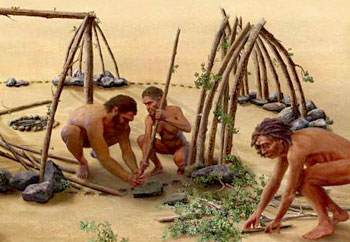
When the great ice sheets that covered much of the land began to retreat northwards and the climate became warmer, man was able to come out of his cave dwellings and build huts above the ground. As the ice melted it gave rise to streams and rivers. There were also new lakes to be explored. All these waters were teeming with animal life such as fish and fowl which provided a ready supply of food.
Once the ice had gone, dense forests of willow and birch sprang up. Thousands of different kinds of birds lived in the branches and they were an easy target for man to shoot down with his bow and arrow. There was a whole new world to explore.
Man becomes a woodsman, a fisherman and a wildfowler. This new life had a great influence on social relationships between people. To get the best results possible from hunting and other forms of human activity, people came together in groups and formed the first tribes. These communities then became larger as life grew more complex. It became evident that people had to live and work together as a group to carry out all the operations necessary for living.
The basic nucleus of this community was the family. There was never a lack of work for the various members of the tribe. There were trees to be felled, huts to be built or repaired, fishing nets to be made from cords obtained from dried plant fibres. The work of women was more concerned with the home. They made rugs out of tree-bark to make their homes more comfortable; they made clothes of skin, sewn with bone needles; they cleaned and gutted the fish the men caught in abundance and dried it in the Sun; they cooked meals, gathered the fruits of the earth and prepared food stores for the winter.
Picture Credit : Google

